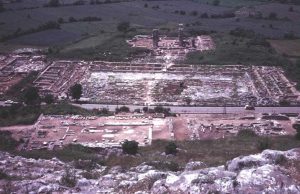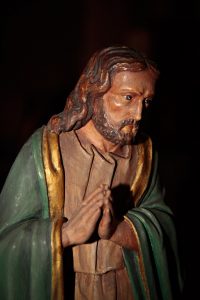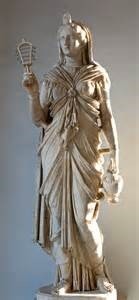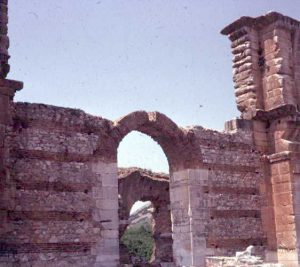In Part I, we presented an overview of the legendary correspondence between King Abgar of Edessa and Jesus, noting its popularity and how it was preserved in both literary and archaeological sources. Here we will look specifically at the archaeological sample found at Philippi in northern Greece. As we have noted elsewhere, Philippi is important in church history and in the history of the West in part because of its connection with St. Paul.
 Found in twelve fragments, the text from Philippi resembles one recorded in the church historian Eusebius’ Ecclesiastical History I.13, which dates to around 325 CE. The archaeologist at Philippi, Charles Picard, conjectured that the Philippian example was composed between 325 and the mid-fifth century CE; epigraphic expert Denis Feissel suggests the fifth or sixth century.
Found in twelve fragments, the text from Philippi resembles one recorded in the church historian Eusebius’ Ecclesiastical History I.13, which dates to around 325 CE. The archaeologist at Philippi, Charles Picard, conjectured that the Philippian example was composed between 325 and the mid-fifth century CE; epigraphic expert Denis Feissel suggests the fifth or sixth century.
As we noted in Part I, the Abgar-Jesus letters were found on an amulet near an altar at Philippi bearing a dedication to the all-powerful Egyptian Goddess Isis, entrusting the city to her protection. The altar had been moved in antiquity to its archaeological find-spot near the southeast gate of the city on the road leading to Philippi’s port city of Neapolis (modern Kavala). This altar, dedicated to “Queen Isis,” with a dove and cross carved into it, was also found near an inscription to Jesus bearing a reference to Mary.
![]() So at Philippi, a city known to early Christians as a city visited by St. Paul and attested to by his letter to these Christians as found in the Bible, we have a third-century altar that had been moved to the city gate in antiquity; an inscription on it dated to the fifth or sixth century; an amulet appealing to Jesus for healing and protection; an appeal to the goddess Isis for protection; and Christian symbols carved onto a pagan altar that was not destroyed in the Christian era.
So at Philippi, a city known to early Christians as a city visited by St. Paul and attested to by his letter to these Christians as found in the Bible, we have a third-century altar that had been moved to the city gate in antiquity; an inscription on it dated to the fifth or sixth century; an amulet appealing to Jesus for healing and protection; an appeal to the goddess Isis for protection; and Christian symbols carved onto a pagan altar that was not destroyed in the Christian era.
These juxtapositions are striking. They strongly suggest that the people of Philippi – feeling threatened in the early Byzantine era by any number of challenges, such as barbarian attacks, earthquakes and perhaps disease – were appealing to a number of deities, not just the Christian God, for protection and assistance.
Here is the text of the Philippian example (translation by Feissel):
- “Abgar, son of Uchamas, toparch, to Jesus the good savior who has appeared in the city of Jerusalem, greeting. I have heard spoken about you and your healings that you have performed (them) without herbs or drugs. It has been said that you have given sight to the blind, made the lame walk, cleansed the lepers, exorcised unclean spirits and cured those who have been long afflicted. Having been apprised of all these things about you, (I am persuaded) that you are God (. . . and that you are the Son of God, you who accomplish) these things. Therefore, (I beseech you to take the trouble to come find me and cure) the malady (which I suffer. I have heard that the Jews plot) against you but (I have a city), (which) though very small (is yet noble and sufficient for both of us).”
- “Blessed are you who have believed in me without seeing me.
 For it is written of me that those who have seen me will not believe in me, but those who have not seen me, those are the ones who will believe and live. With regard to what you have written me, that I should come find you, I must finish here all that I have been sent to do and then to ascend to the one who sent me. After my ascension I will send you one of my disciples that he may obtain for you and your city and those with you eternal life and peace. And I will make your city strong so that none of your enemies will have power over you, nor will they ever prevail.”
For it is written of me that those who have seen me will not believe in me, but those who have not seen me, those are the ones who will believe and live. With regard to what you have written me, that I should come find you, I must finish here all that I have been sent to do and then to ascend to the one who sent me. After my ascension I will send you one of my disciples that he may obtain for you and your city and those with you eternal life and peace. And I will make your city strong so that none of your enemies will have power over you, nor will they ever prevail.”
Feissel (Recueil, 185-89) demonstrates that several lines of the Philippian example do not correspond to Eusebius’ version of the text; instead, on the basis of the layout of the fragments and the number of letters estimated per line, they agree more closely with the texts from Pontus or Ephesus. Feissel’s translation presented here is slightly different from the one offered by archaeologist Picard, but both resemble Eusebius’ translation at their main points. Interestingly, the letters on Jesus’ response in the Philippian version are larger and more widely spaced than those of Abgar’s portion.
The Abgar-Jesus correspondence as a public or private amulet with magical powers raises three issues about the religious atmosphere: 1) rites and/or consecration ceremonies that might have been held in conjunction with the inscription and any incantations said or hymns sung during those rites; 2) the inscription tablets as a possible variation of traditional curse tablets; and 3) the healing factor in its public and private forms.
Rites and ceremonies. The ancient and modern literature indicates that rites of various kinds were used in conjunction with amulets and other objects of magic in order to endow the objects with their efficacious powers. Rituals included initiations and deification, invocations for séances with deities and instructions for preparing ingredients. Manuscripts such as the Greek Magical Papyri contain innumerable spells that were sold in the marketplace or used by the magicians themselves.
Incantations and hymns were often part of the power-inducing ritual. Incantations “were widely used in medicine (healings, exorcisms), weather magic, cultic invocations of gods and demons, and erotic magic” (Betz, “Magic,” 94). Hymns, composed metrically and sung and accompanied by instruments and dance, contained the invocation of the gods, the gods’ names and epithets and finally the petition.
While there is no direct evidence that rites were held in conjunction with the inscriptions at Philippi’s city gate, it is entirely possible that some occurred, at least sporadically and perhaps in conjunction with that city’s Isis altar.  The Isis cult had become popular at Philippi by the third century CE, with healing as one of her main functions. Her followers constructed an elaborate worship center in close proximity to the Diana (Artemis) and Sylvanus sanctuaries, and her cult survived until at least the fifth century, well into the Christian era.
The Isis cult had become popular at Philippi by the third century CE, with healing as one of her main functions. Her followers constructed an elaborate worship center in close proximity to the Diana (Artemis) and Sylvanus sanctuaries, and her cult survived until at least the fifth century, well into the Christian era.
It is not inconceivable that the citizens of the town, fearing barbarian invasions, disease or natural disasters (e.g., earthquakes), gathered to perform rituals around the inscription and altar in order to implore the deities’ protection. It is interesting that the Philippian example of the Abgar-Jesus letters, rather than being concerned about the threat of Jews, heretics or pagans as some examples were, focused on illness and the city’s protection, concerns specific to that community; apparently the wording of the correspondence was adapted to fit specific situations, as might be expected.
Curse tablets. Curse tablets, another instrument of magic in the ancient world, were made of lead, pottery shards, seashells and papyri, on which the curse formulas were written along with the names of those cursed and those doing the cursing. Such tablets were placed in the ground close to where it was thought dead spirits abided, such as houses, baths and sports arenas; the purpose was to direct the curse to the avenging underworld deities such as Hermes, Hekate or Persephone.
A special form of the curse tablet was the magical letter to underworld deities. Could the Abgar-Jesus tablets be a variant of this practice at Philippi and elsewhere? The deity, Jesus, is said in the exchange to ascend to heaven, but in the church’s Nicene Creed, Jesus “descended into Hell” as well, thus becoming an underworld deity of sorts. Also, by their placement at the city gate, the tablets are in ground considered in earlier times to be inhabited by the traditional deities who protect boundaries and entryways. While the basic intent of the Philippian letters was to ask for healing and protection, they also contained wording about destroying, harming or otherwise impeding evil forces, as did curse tablets.
Healing. The healing element of the inscriptions is paramount: the healing of King Abgar and, by extension, all citizens of Philippi is the primary purpose of the amulet, especially but not only in its personal form. Almost every cult in antiquity had healing as a primary concern, and at Philippi, healing was a major focus of all the large cults, including Isis. Healing was not confined to the curing of disease but also linked with protection of the community, the city, from all threats.
In many ways, the Abgar-Jesus inscription represents the epitome of the religious scene at Philippi during the early Byzantine era. People needed their gods and the magical practices that helped them influence those gods. Philippians needed basic acts of individual healing and protection as a community from threats such as invading barbarians, natural disasters, unfriendly demons and evildoers in their own midst.
Conclusions
The Abgar-Jesus correspondence at Philippi and elsewhere is an example of the melding of “magic” and “religion.” While still not totally triumphant in the fourth through sixth centuries, Christianity was clearly a strong religious force in this and other communities. The Abgar-Jesus legend reflects the core of the Christian message: the sovereignty of the healer Jesus, the “good Savior” and son of God, who has disciples and ascends into heaven.
 Yet the history of the correspondence and the inscription’s placement near the city gate demonstrates that the people of Philippi were not only appealing to the Lord Jesus at worship services in church or at home: they were also using physical objects, and probably rites connected with them, in a manner more properly deemed magical. This example of magic in a Christian setting shows once again that Christian practice owed much to its pagan heritage.
Yet the history of the correspondence and the inscription’s placement near the city gate demonstrates that the people of Philippi were not only appealing to the Lord Jesus at worship services in church or at home: they were also using physical objects, and probably rites connected with them, in a manner more properly deemed magical. This example of magic in a Christian setting shows once again that Christian practice owed much to its pagan heritage.
Similarly, the use of the legend as an amulet at Philippi, especially in the context of placement near a city gate, further highlights the relationship between traditional pagan practices and early Christianity well after the time of Jesus, Paul and the first disciples. The amulet gives us a hint at the perils that Philippians felt they were facing. They seemed to believe, like King Abgar, that Jesus could heal and protect them from all manner of enemies. But they also hedged their bets – by appealing to Isis, a powerful female deity, and her Christian counterpart, Mary. Even as late as the fifth or sixth century CE, Christianity was not monolithic.
While Walter Bauer may be correct in theorizing that the legend was started by the “orthodox” Bishop Kûne around 313 CE and “planted” in Eusebius’ sources to establish the heritage of Edessa as orthodox, this “planting” may be another example of “proscriptive” intent rather than “descriptive” reality. That is, while there may well have been an attempt on the part of what was beginning to be the established church to combat so-called “heresy” with the Abgar-Jesus legend, the truth may be that the enormous variety of belief and practice in the early church remained difficult for church leaders to overcome.
The Abgar-Jesus legend is a fascinating remnant from the early Christian world that comes to us in both literary and archaeological forms. It is an invitation to us to examine how we view Jesus, the nature of our own “brand” of Christianity, if we call ourselves Christian, and the place of healing in our religious practice.
Note: A version of this post originally appeared in Abrahamsen, Goddess and God, pages 86-94.
Resources
“Abgar, Legend of,” in F.L. Cross and E.A. Livingstone, eds., The Oxford Dictionary of the Christian Church, 5. Oxford: Oxford University Press, 1983.
Abrahamsen, Valerie A. Goddess and God: A Holy Tension in the First Christian Centuries. Marco Polo Monographs 10. Warren Center, PA: Shangri-La Publications, 2006.
Abrahamsen, Valerie A. The Rock Reliefs and the Cult of Diana at Philippi. Harvard University dissertation, 1986; Ann Arbor, Mich.: University Microfilms, Inc., 1986.
Abrahamsen, Valerie A. Women and Worship at Philippi: Diana/Artemis and Other Cults in the Early Christian Era. Portland, ME: Astarte Shell Press, 1995
“Addai,” in F.L. Cross and E.A. Livingstone, eds., The Oxford Dictionary of the Christian Church, 16. Oxford: Oxford University Press, 1983.
Bauer, Walter. “The Abgar Legend,” in Edgar Hennecke and Wilhelm Schneemelcher, eds., New Testament Apocrypha, Vol. I, 438. Philadelphia: Westminster Press, 1963.
Bauer, Walter. Orthodoxy and Heresy in Earliest Christianity, ed. Robert A. Kraft and Gerhard Krodel. Philadelphia: Fortress, 1971; German original, Rechtglaubigkeit und Ketzerei im ältesten Christentum. Tübingen: Mohr/Siebeck, 1934.
Betz, Hans Dieter. “Magic: Magic in Greco-Roman Antiquity,” in Mircea Eliade, editor-in-chief, Encyclopedia of Religion, Vol. 9, 93-97. New York: Macmillan Publishing Co., 1987.
Enslin, M.S. “Abgarus, Epistles of Christ and,” in Interpreter’s Dictionary of the Bible, Vol. I, 5. New York and Nashville: Abingdon Press, 1962.
“Etheria, Pilgrimage of,” in F.L. Cross and E.A. Livingstone, eds., The Oxford Dictionary of the Christian Church, 473. Oxford: Oxford University Press, 1983.
Feissel, Denis. Recueil des inscriptions chrétiennes de Macédoine du IIIe au VIe siècle. Athens and Paris: Bulletin de Correspondance Hellénique Supplement 8, 1983.
Howard, George, trans. The Teaching of Addai. Chico, CA: Scholars Press, 1981.
Jones, Christopher. “The Letters of Abgar V,” https://gatesofnineveh.wordpress.com/2011/08/04/the-letters-of-abgar-v/; accessed 12/10/20.
McVey, Kathleen E. “Abgar, Epistle of Christ to,” Anchor Bible Dictionary, Vol. 1, 12. New York: Doubleday, 1992.
Picard, Charles. “Un texte nouveau de la correspondance entre Abgar D’Osroène et Jésus-Christ gravé sur une porte de ville, à Philippes (Macédoine),” Bulletin de Correspondance Hellénique 44 (1920) 41-69.
Youtrie, Herbert C. “A Gothenburg Papyrus and the Letter to Abgar,” Harvard Theological Review 23 (1930) 302.
